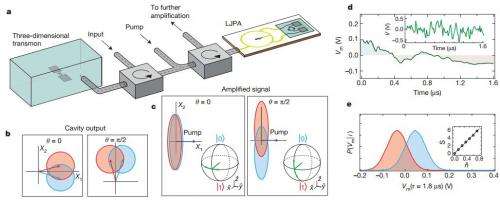October 10, 2013 report
Researchers devise a means to observe single quantum trajectory of superconducting quantum bit

(Phys.org) —A team of physicists at the University of California has devised a means for allowing the observation of the quantum trajectory of a superconducting quantum bit. In their paper published in the journal Nature, the team describes how they used a three dimensional transmon and microwaves to observe the random path of a quantum state as it collapsed from its superposition state to a classically permitted state.
Quantum states, are of course, very delicate by their very nature. Interactions with the surrounding environment can destroy them causing them to collapse to a classical state. This is why it's so difficult to measure what is going on—the very process of doing so changes what happens. But difficult isn't the same as impossible as the team of researchers in California has discovered. They found a way to measure what is going on during the process—called the trajectory—by having it occur in a transmon (a type of superconducting charge qubit designed to be less sensitive to charge noise) as microwaves were sent in and then measured as they came out. In so doing they measured either the phase or the amplitude of the cavity field, but not both, a form of measurement so weak that it wouldn't cause a collapse to a classical state. This was possible because the resonance of the microwaves was far off the frequency needed to drive the system between states. Thus no absorption occurred. The system set up by the team works because it was capable of continuous monitoring, allowing for measuring the quantum trajectory by taking readings of the microwaves as they emerged from the transmon and then averaging them together.
Finding a way to follow the trajectory of qubits is critical if true quantum computers are to be built and used some day, as is a need for controlling, or steering the process—which the researchers found they were also able to do using the same system. The apparatus put together by the researchers doesn't solve the problem of trajectory observation entirely, of course, nor does it allow for a clear way to steer it in a desired direction. Instead, it's an important step in the right direction, adding more credence to the very idea of a quantum computer.
More information: Observing single quantum trajectories of a superconducting quantum bit, Nature 502, 211–214 (10 October 2013) DOI: 10.1038/nature12539
Abstract
The length of time that a quantum system can exist in a superposition state is determined by how strongly it interacts with its environment. This interaction entangles the quantum state with the inherent fluctuations of the environment. If these fluctuations are not measured, the environment can be viewed as a source of noise, causing random evolution of the quantum system from an initially pure state into a statistical mixture—a process known as decoherence. However, by accurately measuring the environment in real time, the quantum system can be maintained in a pure state and its time evolution described by a 'quantum trajectory'1, 2 determined by the measurement outcome. Here we use weak measurements to monitor a microwave cavity containing a superconducting quantum bit (qubit), and track the individual quantum trajectories3 of the system. In this set-up, the environment is dominated by the fluctuations of a single electromagnetic mode of the cavity. Using a near-quantum-limited parametric amplifier4, 5, we selectively measure either the phase or the amplitude of the cavity field, and thereby confine trajectories to either the equator or a meridian of the Bloch sphere. We perform quantum state tomography at discrete times along the trajectory to verify that we have faithfully tracked the state of the quantum system as it diffuses on the surface of the Bloch sphere. Our results demonstrate that decoherence can be mitigated by environmental monitoring, and validate the foundation of quantum feedback approaches based on Bayesian statistics6, 7, 8. Moreover, our experiments suggest a new means of implementing 'quantum steering'9—the harnessing of action at a distance to manipulate quantum states through measurement.
Journal information: Nature
© 2013 Phys.org





















